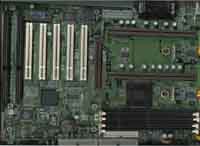Pine Technology BA1-D Dual BX
by Anand Lal Shimpi on June 15, 1999 5:21 PM EST- Posted in
- Motherboards
We all know what pine trees are, for nature lovers, they add a beautiful green to any outdoor scene, for car owners, they have danger zone written all over them. Which connotation can be applied to the products of Pine Technology?
AnandTech's first experience with a Pine Tech motherboard was their ZX based ZA3, and while the experience wasn't a stellar one it did set the standard Pine Tech motherboards should live up to. In the case of Pine's next contribution to the motherboard market, the dual processor BA1-D does have much higher standards to live up to if it is to become a successful product. The dual processor motherboard market is a much more picky one than the single processor Socket-370 market, Pine does have one advantage going for them however, that advantage is price.
For a company that produced 5 million boards last year (not just motherboards, mainly modems and other such peripherals), Pine definitely has a strong background in the OEM market however their mainstream acceptance remains untested as a very small percentage of those 5 million boards made their way into the hands of hard core tweakers and gamers. Is Pine due for a change? There's only one way to find out...
| CPU Interface | Dual Slot-1 |
| Chipset | Intel 440BX |
| On-Board Video | N/A |
| L2 Cache | N/A (on-chip) |
| Form Factor | ATX |
| Bus Speeds | 66/100 |
| Clock Multipliers | 3.0x - 5.5x |
| Voltages Supported | 2.0v/2.8v (Auto Detect) |
| Memory Slots | 4 168pin DIMM Slots |
| Expansion Slots | 1 AGP Slot 0 AMR Slot 5 PCI Slots (1 Full Length) 2 ISA Slots (2 Full Length) |
| BIOS | Award BIOS |
The Good
| The BA1-D is the first dual processor BX motherboard AnandTech has reviewed that doesn't look like a dual processor motherboard. Built on a PCB that's about the size of the single processor ABIT BX6, the BA1-D doesn't carry too many case requirements other than your standard mid-tower ATX case. Keep in mind that the positioning of the 4 DIMM slots may rule out some cases, however that problem is already well know by ABIT BX6 users and is common to most motherboards of this size. As with most dual BX boards, the 4 DIMM slots are placed almost flush with the 443BX controller in hopes of decreasing trace lengths and improving stability. | |
| The board's 5/2/1 expansion slot configuration (PCI/ISA/AGP) is commonplace with most desktop single processor BX motherboards, and has made its way to Pine's BA1-D in hopes of making the board more of a high-end desktop workstation motherboard. The market for dual processor motherboards has definitely increased since just two years ago, and with Windows 2000 on the horizon not to mention dual processor support in idSoftware's Quake 3 Arena, you can expect multiprocessor motherboards to not only drop in price but also be offered in a new variety. Rather than the same old server or workstation markets for dual processor motherboards, the high end desktop market is a growing one that will soon emerge in the dual processor motherboard market as well. If anything, Pine's BA1-D is the first example of a high end desktop dual processor motherboard. Why? | |
The BA1-D is your run-of-the-mill BX board with a second SC242 (Slot-1) processor interface and a SMP ASIC for dual processor operation. Nothing more, no on-board ethernet, no on-board SCSI, just a dual processor BX board. The benefits this type of design offers over the more conventional dual processor BX board with more server/workstation features in mind is that the BA1-D offers basic dual processor operation, at an affordable price. To those users that can't afford SCSI hard drives, and don't need support for redundant power supplies, then the BA1-D gives them everything they need at an affordable cost.
Contrary to Pine's own spec sheet, the BA1-D is not a jumperless motherboard. The board, by default, performs a B21 state detect meaning it determines whether you are running a 66MHz or 100MHz FSB processor. In the event that a 66MHz FSB processor is installed alongside a 100MHz FSB processor the board defaults to the 66MHz FSB, with no jumper that toggles between B21 states. The board features no additional FSB settings other than the 66/100MHz settings officially supported by Intel for use with the BX chipset, the lack of any overclocking options can be expected considering that most OEMs, Pine's primary source of sales, don't really care about overclocking at all and would rather the potential not be there to save them any tech support calls from users asking why "the 133MHz setting crashed my computer." The clock multipliers are controlled by an 8-pin jumper block adjacent to the secondary IDE connector. The available documented settings range from 3.0x to 5.5x, unfortunately the BA1-D only comes with two jumpers for use on the 8 pins, so if you plan on using the 3x or 4x settings, make sure you have another jumper handy or have a tiny piece of metal to connect two more pins with.











0 Comments
View All Comments